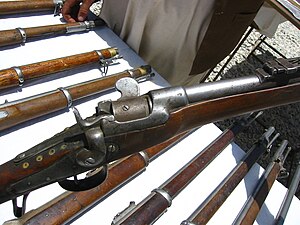Werndl–Holub rifle
Appearance
| M1867 Werndl-Holub | |
|---|---|
 The unique breechloading system of the Werndl | |
| Type | Service rifle |
| Place of origin | |
| Service history | |
| In service | 1867 - 1888 |
| Used by | Austria-Hungary, Persia |
| Wars | Balkan Wars, World War I[1] |
| Production history | |
| Designed | 1860s |
| Manufacturer | Steyr |
| Produced | 1867 |
| Variants | M.1867/77 |
| Specifications | |
| Mass | 9.65 lb |
| Length | 50.4 in |
| Barrel length | 33.3 in |
| Cartridge | 11.15x42mmR (Infantrie und Jäger Gewehre M.67) 11.15x58mmR |
| Caliber | 11.15mm |
| Action | rotating drum bolt |
| Feed system | single-shot breach loading |
| Sights | Iron |
The M1867 Werndl-Holub was a single-shot breechloading rifle adopted by the Austro-Hungarian army in 1867. It replaced the breechloader-conversion Wanzl rifle. The rifle was designed and patented by Josef Werndl (1831-1889) and Karel Holub (1830-1903); Werndl later bought out all the rights.
It was produced by Steyrwerks, and chambered for the 11mm scharfe Patrone M.67 [1] (11.15x42R) cartridge. In 1877 they were rechambered for the bottleneck 11mm scharfe Patrone M.77 (11.15x58mmR) cartridge.
In spite of being long obsolete at the time, Werndl rifles were issued to rear-echelon units of the Austro-Hungarian forces during World War I to free up more modern rifles for use by front-line troops.[1]
See also
- ^ a b c Scarlata, Paul (August 1, 2011). "Austro-Hungarian Rifles of World War 1 - Part One: Many Peoples - Many Rifles!". Shotgun News. 65 (21): 48.
{{cite journal}}:|access-date=requires|url=(help)
